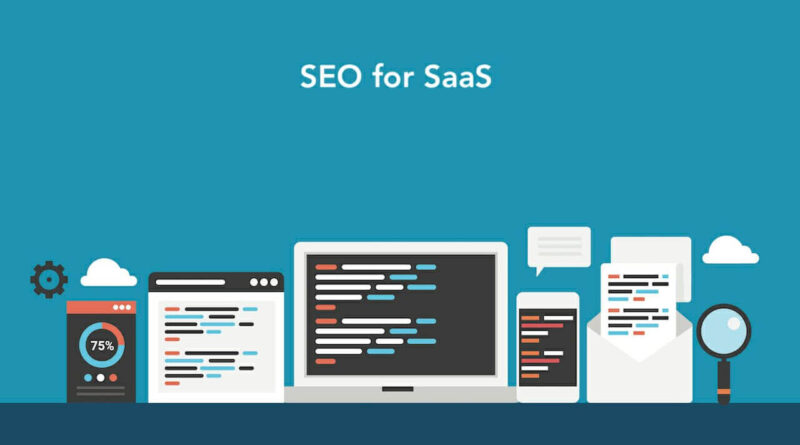SEO for SaaS: How to Improve Organic Traffic Growth and Take Your SaaS to the Next Level
SEO for SaaS is a strategy that uses Content Marketing and keyword research to drive traffic to the website of a company offering software as a service .
Understanding how search engines and keywords work will help you develop an effective content strategy, as well as a solid SEO to, in this way, attract leads to your blog and portal.
In the next lines of this article we will explore SEO for SaaS in greater depth, its great importance and the best practices to apply it.
But, first, let’s do a brief review of the emergence of software as a service and its value proposition from a technological and functional point of view.
The conventional Anti-Software Company
Table of Contents
When he defended the “end of software”, Benioff was referring to the conventional system of storage and restricted operation in a certain network of computers, which is less and less used due to its limitations.
More than twenty years ago , Salesforce.com, a San Francisco-based startup, disrupted the conference held by a large traditional enterprise software company and essentially launched the software-as-a-service (SaaS) revolution.
SaaS companies now dominate the sales and marketing technology industry and continue to grow.
So what did the SaaS model bring with it?
On the one hand, the SaaS model transformed software delivery. Companies no longer needed to spend millions on complicated software and hardware, and maintenance contracts disappeared.
This Internet business model based on subscription software services included updates and maintenance, which reduced the cost of computing and gave millions of people access to the same software used by companies.
Why should SaaS companies invest in SEO?
After this introduction and anecdotes about the SaaS model, it’s time to talk about why companies in this industry need to invest in search engine optimization.
Investing in performance advertising often backfires as SaaS companies spend the investment cash before the business scales.
SEO and Content Marketing do not require as much investment as results-based advertising, so the cost is much lower.
However, it takes time and well thought out strategies to create successful SEO campaigns within this methodology.
What Makes SEO for SaaS Different?
Retail companies focus on products and brands to drive traffic to their website. Healthcare companies can focus on specific illnesses that their patients may suffer from.
But starting SaaS companies don’t have a popular brand or product that can be used to drive traffic to their website.
For this reason, SaaS must develop keyword strategies that focus on the problems that buyers need and want to solve.
” Generate more leads without advertising ” can be a keyword phrase used by SaaS SEO providers to drive traffic to a page of interest.
These long-tail keywords tend to generate fewer visits, but they are also less competitive and allow traffic to be qualified, which optimizes the investment.
Building a library of these phrases will improve your search results in the long run.
10 steps to creating a successful SaaS SEO campaign
Now is the time to focus on the practical! If you are in charge of the Digital Marketing of a SaaS and want to create a powerful and precise SEO campaign, we recommend that you follow the following steps:
1. Set realistic goals
Creating realistic goals is the first step in establishing a successful SEO campaign. Goals must be measurable and achievable.
For example, if this is just your first SaaS SEO campaign and your blog is in the making, setting a goal to appear number one in a Google search result within the first month would not be realistic.
SEO and Content Marketing take time to build traction, and goals should reflect that reality. A better goal would be, for example, to position three keyword phrases in the top 10 within six months.
2. Identify the KPIs
Once you have set your goals, you will need a way to measure results. The key performance indicators are essential metrics for this.
Website visitors, search result placements, and monthly searches are great SEO KPIs.
These indicators can be measured using different analytical tools, both free and paid.
One of the most important KPIs is comparing how your SEO ranks against other competitors in the SaaS market.
How does your website rank in Alexa, a website comparison software? How many keywords are in the top 10 on Google compared to your top two or three competitors?
It is useful to pay attention to growth. It will be satisfying to see your ranking improve as you promote your keywords through blogs and social media.
3. Create buyer persona profiles
Identifying the characteristics of potential buyers is the next step in developing an effective SEO program. Therefore, it is a good idea to divide your prospects into different categories.
For commercial products, for example, your buyer might be an IT director or a marketing manager. For consumer or e-commerce products, you could be a millennial woman who lives in a popular part of town and enjoys gardening.
It’s good practice to include extensive details about your shoppers, including their social media habits, what software they use, and even whether they own an iPhone or Android.
For example, HubSpot can identify your key customer as Marketing Manager Mary or Business Owner Bob.
The buyer persons are essential for keyword research. Your buyers will search for different phrases based on their needs and challenges.
Marketing manager Mary may want to increase lead generation, while business owner Bob wants to sell his business.
Interviewing sellers, distributors and customers will shed light on the audience that SEO for SaaS should target to drive more sales.
4. Research your competition
You can learn a lot from your competition. What keywords do you use? Do you spend money on pay-per-click advertising or do you use Content Marketing?
Understanding how your SaaS software competition uses SEO will give you insight into their strategies and goals.
You don’t need to research every company in your niche. Select two or three that are close and especially relevant, and research their keywords, spending habits, and search results.
It is also not mandatory that you hire a market research company. Instead, use the same SEO software that you use for your keyword research.
SEMrush is a popular paid search advertising research tool. Create a table comparing your campaign with your competition.
5. Do keyword research
Keywords are the SEO fuel for SaaS, as for any other type of business. Finding the right keywords is a mix of art and science.
A keyword may seem like a good fit for your SEO campaign, but if it is too competitive or not generating enough traffic, you may not want to use it to develop your campaign.
Competitive keywords are expensive to use for paid advertising. It will also be a challenge to find a position in the top 10 search results in organic SEO.
For example, let’s say you sell a SaaS video content editor and you want to rank for the keyword “YouTube.”
You will face more than 180 million competitors, while “YouTube” is the number one keyword in the world, according to Ahrefs .
Once you start your SEO program, you will want to keep track of your search ranking. Google displays 10 search results per page and provides rankings for the top 100 related search terms.
You’ll increase your ranking as you generate more content around that keyword phrase. Every page counts, including landing pages, blog posts, and website pages.
Make sure to include the keyword in your website’s page title at least one or two more times. Use variations of the term.
On the other hand, avoid the excess of keywords, which is the use of them over and over again, without introducing them to the text in a natural and coherent way.
Google is very difficult to deceive and will penalize you for this tactic, placing you on its blacklist .
6. Generate content in different formats, always with an SEO approach
For a SaaS business, the most important KPI is revenue growth.
To earn income, you must generate leads. But how do you do that on your website?
When your buyers are in the awareness stage of the buying process , they want to find a solution to their problem and turn to Google.
They find articles based on the keywords in your questions and visit company landing pages or website pages that provide those answers. That’s great, but it’s not everything.
You have the audience and you need to transform it into leads. To convince someone to give you their personal information, such as email, name and company, you need to add value.
That’s where Content Marketing comes in. There are many types of content and you should combine different formats for best results. Here are some of the most popular types.
Videos
YouTube is the second most popular search engine after Google. People love videos – tutorial videos, vlogs (videoblogs), dance videos, and music all generate a lot of traffic based on keywords.
The following screenshot illustrates the value of videos and keywords. The keyword «fun tutorial videos» – in Spanish, funny tutorial videos – has allowed a simple and short video – «How to Make a Tutorial Video» – to get more than 500 thousand visits.
Blog posts
People still read in short chunks. Blogs are informative and motivating. They are easy to produce, but you need to post regularly.
If you can’t do it yourself, using a Content Marketing agency will make your life easier.
Ebooks
Buyers also like to read longer documents, such as ebooks and white papers.
This longer format is often called evergreen content , as it is written to last for a long time. This option provides a lot of SEO value over time and can produce results for years.
Infographics
Pictures tell stories. The infographics combine facts, numbers and words to create exciting content.
Infographics often accompany a blog post or piece of evergreen content to raise awareness.
7. Above all, write by and for the reader
Google wants you to have a pleasant search experience. He wants you to find relevant content quickly. He also wants you to enjoy the reading experience.
Writing content solely with search engines in mind will not meet these criteria. Your writing should be pleasant and informative. The more relevant your text is, the better the ranking will be.
The term “SEO for SaaS” is key to this article. But you may have noticed it written in a variety of ways. Google algorithms recognize synonyms and variations, allowing us to write more naturally.
8. Link to relevant website pages
Your content must be well written and come from a respected source. Providing links within your articles to other resources creates respect from readers.
The key is to provide links to other pages within your website. These internal links increase your on-page SEO .
The second factor is linking you to credible external sites. You should avoid links to websites that are your competitors or of dubious reputation.
9. Measure your SEO results
Remember our discussion on key performance indicators and metrics? You must demonstrate to your boss or client that your SEO program is generating results.
Measuring your KPIs, such as website traffic, clicks, and leads, provides the evidence you need to keep your campaign funded.
Gathering those leads in one central location makes it easy to view progress. You can use SEO software, a marketing automation platform, or an analytics application.
Using a SaaS software solution means that your statistics are updated in real time, providing instant feedback.
10. Analyze and review the strategy
It is important that you pay attention to your metrics, do not resist change and make adjustments in time, this is vital to improve SEO results.
Over time, your SEO results will improve if you monitor your keyword terms and add new content.
Conduct regular review sessions with your content and SEO team and brainstorm new terms and keyword topics.
Pay attention to what customers and prospects ask in your email and social media communications.
It is useless to publish or create content and forget it. You will lose momentum and all your efforts will go to waste.
Organic SEO is a powerful tool and it takes time to create a solid Inbound Marketing program . Your efforts will pay off by keeping your campaign up-to-date and relevant.
As you can see, SEO for SaaS is a complex subject to understand. You must understand the needs and challenges of your buyer, how your product and service are unique, and find ways to present relevant content on the Internet.
The SaaS environment is very competitive – search engine optimization is no exception.
Developing buyer persona profiles, creating quality content relevant to the awareness stage, and using forms to convert those readers into potential customers will be essential for the campaign.
Remember, you must be patient and persistent. Organic SEO methods take time to build and generate leads. You will need a constant stream of blog posts to attract and convert.
The most important thing is to set goals and KPIs and measure the results so that you can constantly improve in the process.



